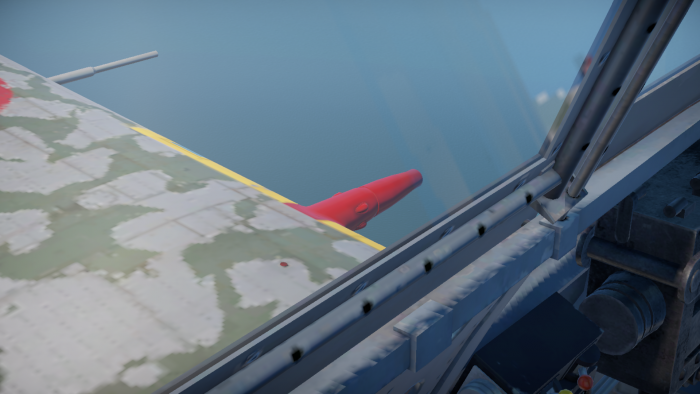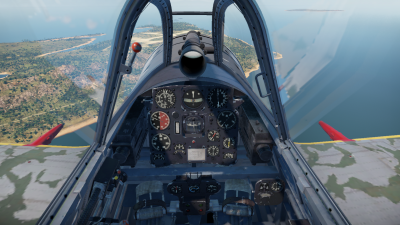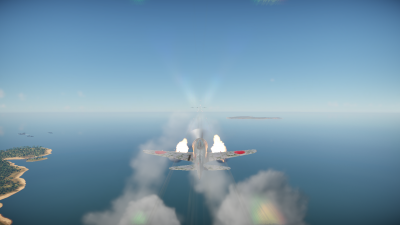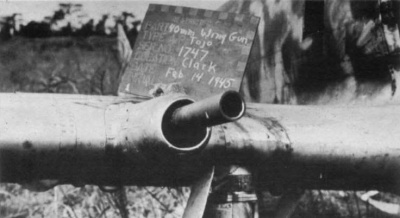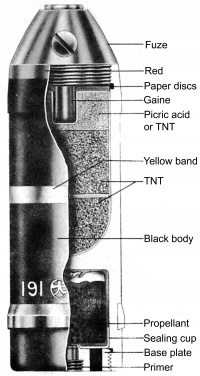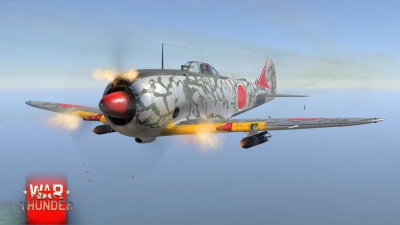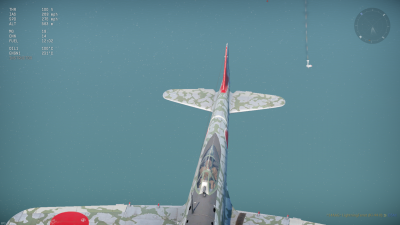Difference between revisions of "Ho-301 (40 mm)"
(→History: added history) (Tag: Visual edit) |
(Page overhaul with additions to all sections) (Tag: Visual edit) |
||
| Line 1: | Line 1: | ||
| + | [[File:Ho-301 mounted on Ki-44-II otsu.png|alt=40mm Ho-301 cannon in the left wing of the Ki-44-II otsu|center|thumb|700x700px|Ho-301 cannon in the left wing of the Ki-44-II otsu, painted in red]] | ||
| + | |||
== Description == | == Description == | ||
| − | + | The Ho-301 is a Japanese 40 mm aircraft cannon intended for the anti-bomber role. It is unusual as it uses low velocity caseless ammunition and is solely mounted on the Ki-44-II otsu in-game. | |
| + | [[File:Ki-44-II otsu cockpit.png|alt=Cockpit of the Ki-44-II otsu|thumb|400x400px|Two Ho-301 cannons on the Ki-44-II otsu]] | ||
=== Vehicles equipped with this weapon === | === Vehicles equipped with this weapon === | ||
| Line 8: | Line 11: | ||
== General info == | == General info == | ||
| − | + | The Ho-301 has a relatively low firerate and its rounds have very low velocity. Due to the design of the weapon and its ammunition, accuracy is poor at any range. The low ammunition count will cause this weapon to run dry in slightly less than two seconds of firing time. | |
=== Available ammunition === | === Available ammunition === | ||
| Line 43: | Line 46: | ||
|- | |- | ||
|} | |} | ||
| + | |||
| + | [[File:Ho-301 firing, Ki-44-II otsu.png|alt=Ho-301 firing, Ki-44-II otsu|thumb|400x400px|Ho-301s firing, displaying very large muzzle blasts]] | ||
=== Comparison with analogues === | === Comparison with analogues === | ||
| − | ' | + | Due to this weapon's unique properties, it has very few true analogues in game. In fact, because of its low velocity rounds and high explosive mass, it is almost more similar to grenade launchers like the helicopter-mounted 40 mm [[M129 (40 mm)|M129]] than it is to other large caliber aircraft cannons. |
| + | |||
| + | Compared to the rest of its class of bomber destroying weapons, the Ho-301 has one of the lowest velocity rounds, largest bullet spread, and has some of the smallest ammunition count of its type. | ||
== Usage in battles == | == Usage in battles == | ||
| − | + | When using the Ho-301, it is recommended to maneuver very close behind the enemy aircraft to increase the chances of shells hitting the target. On the [[Ki-44-II otsu]], these cannons act like secondary weapons as backup to the twin 12.7 mm [[Ho-103 (12.7 mm)|Ho-103]] machine guns. This weapon requires a significant amount of lead, even if the target is in straight and level flight. It is recommended to utilize the Ki-44-II otsu's agility to maneuver the rounds on target. As the Ho-301 was intended to be used against bombers, it is advised to use it as such if the pilot is intending to use this cannon as their main weapon. | |
| + | |||
| + | It is not recommended to use the Ho-301 to attack ground or naval targets due to its very limited ammunition pool and poor accuracy. Its high explosive rounds, while having a great explosive filler, will only be able to damage unarmored or open top targets. | ||
=== Pros and cons === | === Pros and cons === | ||
| Line 55: | Line 64: | ||
'''Pros:''' | '''Pros:''' | ||
| − | * | + | * Shells have high explosive mass and can obliterate aircraft components |
* Effective versus heavy aircraft | * Effective versus heavy aircraft | ||
| − | * Recoil can be used | + | * Due to the [[Ki-44-II otsu]] being rarely encountered and looking nearly identical to other [[Ki-44 (Family)|Ki-44]]<nowiki/>s, enemy players may not expect to be attacked with this weapon |
| + | * Recoil can be used to slow the aircraft down | ||
'''Cons:''' | '''Cons:''' | ||
* Slow fire rate | * Slow fire rate | ||
| − | * Poor accuracy | + | * Poor accuracy |
| − | * Massive recoil makes aiming | + | * Low muzzle velocity |
| + | * Massive recoil makes aiming difficult | ||
| + | * Recoil will slow the aircraft down | ||
| + | * Very limited ammunition count | ||
| + | * Unusual performance may make it difficult to learn how to use | ||
| + | * No armor piercing ammunition for use against armored targets | ||
== History == | == History == | ||
| − | Intended as an anti-bomber weapon, the Ho-301 is an unusual cannon that uses caseless ammunition. The rounds use | + | [[File:Ho-301 cannon on Tojo fighter, (1945).jpg|alt=Ho-301 cannon on Tojo fighter, (1945)|thumb|400x400px|Photo of captured "40 mm Wing Gun" on "Tojo", February 14, 1945]] |
| + | Intended as an anti-bomber weapon, the Ho-301 is an unusual cannon that uses caseless ammunition. It saw limited use, mounted on specialized Ki-44 and Ki-45 aircraft variants and deployed against Allied forces in defense of the Japanese home islands. | ||
| + | |||
| + | The rounds use an aluminum cup to carry the projectile along with a silk bag holding the propellant and primer. When the primer is struck, the bag of propellant is ignited but the projectile is not launched from the chamber until the pressure causes the cup to burst through exhaust holes in the base. | ||
| + | |||
| + | The Ho-301 suffered from a low velocity and was only effective against bombers close ranges within 150 meters which would cause the aircraft to adopt a position well within range of enemy defensive weapons. | ||
| + | |||
| + | Despite its drawbacks, the Ho-301 became one of the few caseless ammunition weapons to see service with any nation. | ||
| + | |||
| + | [[File:Ho-301 40 mm caseless projectile.jpg|alt=Diagram of 40 mm projectile for Ho-301 aircraft cannon|thumb|376x376px|Diagram of the 40 mm caseless ammunition]] | ||
== Media == | == Media == | ||
| − | + | {{Youtube-gallery|https://youtu.be/Q3vR2Vn4xaM?si=MLNBb8px-AmPaLm5=}} | |
| + | |||
| + | [[File:Ki-44-II otsu.jpg|alt=Official screenshot of the Ki-44-II otsu|none|thumb|400x400px|Official screenshot of the Ki-44-II otsu]] | ||
| + | [[File:Aircraft destroyed by Ho-301 cannons on Ki-44-II otsu.png|alt=Aircraft destroyed by Ho-301 cannons on Ki-44-II otsu|none|thumb|400x400px|Aircraft destroyed after Ho-301 cannons impacted and sheared off its wing]] | ||
== See also == | == See also == | ||
| − | + | Weapons of the same caliber and similar role | |
| + | |||
| + | * [[Rolls-Royce Type BH (40 mm)|Rolls-Royce Type BH]] | ||
| + | * [[Vickers S (40 mm)|Vickers S]] | ||
| + | |||
| + | Weapons of a similar role | ||
| − | * | + | * [[Ho-203 (37 mm)]] |
| − | * | + | * [[NS-45 (45 mm)]] |
== External links == | == External links == | ||
| − | |||
| − | * | + | * [[wikipedia:Ho-301_cannon|[Wikipedia] Ho-301]] |
| − | * | + | * [https://www.bulletpicker.com/pdf/TM%209-1985-5,%20Japanese%20Explosive%20Ordnance.pdf TM 9-1985-5, Japanese Explosive Ordnance] (pg.296) |
| − | |||
{{Japan aircraft cannons}} | {{Japan aircraft cannons}} | ||
[[Category:Aircraft cannons]] | [[Category:Aircraft cannons]] | ||
Revision as of 02:57, 8 November 2023
Contents
Description
The Ho-301 is a Japanese 40 mm aircraft cannon intended for the anti-bomber role. It is unusual as it uses low velocity caseless ammunition and is solely mounted on the Ki-44-II otsu in-game.
Vehicles equipped with this weapon
General info
The Ho-301 has a relatively low firerate and its rounds have very low velocity. Due to the design of the weapon and its ammunition, accuracy is poor at any range. The low ammunition count will cause this weapon to run dry in slightly less than two seconds of firing time.
Available ammunition
- Default: HEFI-T
| Penetration statistics | ||||||
|---|---|---|---|---|---|---|
| Belt | Penetration @ 0° Angle of Attack (mm) | |||||
| 10 m | 100 m | 500 m | 1,000 m | 1,500 m | 2,000 m | |
| Default | 3 | 3 | 3 | 3 | 3 | 3 |
| Belt details | |||||||||
|---|---|---|---|---|---|---|---|---|---|
| Belt | Type of warhead (m/s) |
Velocity (m/s) |
Projectile Mass (kg) |
Fuse delay (m) |
Fuse sensitivity (mm) |
Explosive Mass (TNT equivalent) (g) |
Ricochet | ||
| 0% | 50% | 100% | |||||||
| Default | HEFI-T | 246 | 0.59 | 0.4 | 0.3 | 56 | 79° | 80° | 81° |
Comparison with analogues
Due to this weapon's unique properties, it has very few true analogues in game. In fact, because of its low velocity rounds and high explosive mass, it is almost more similar to grenade launchers like the helicopter-mounted 40 mm M129 than it is to other large caliber aircraft cannons.
Compared to the rest of its class of bomber destroying weapons, the Ho-301 has one of the lowest velocity rounds, largest bullet spread, and has some of the smallest ammunition count of its type.
Usage in battles
When using the Ho-301, it is recommended to maneuver very close behind the enemy aircraft to increase the chances of shells hitting the target. On the Ki-44-II otsu, these cannons act like secondary weapons as backup to the twin 12.7 mm Ho-103 machine guns. This weapon requires a significant amount of lead, even if the target is in straight and level flight. It is recommended to utilize the Ki-44-II otsu's agility to maneuver the rounds on target. As the Ho-301 was intended to be used against bombers, it is advised to use it as such if the pilot is intending to use this cannon as their main weapon.
It is not recommended to use the Ho-301 to attack ground or naval targets due to its very limited ammunition pool and poor accuracy. Its high explosive rounds, while having a great explosive filler, will only be able to damage unarmored or open top targets.
Pros and cons
Pros:
- Shells have high explosive mass and can obliterate aircraft components
- Effective versus heavy aircraft
- Due to the Ki-44-II otsu being rarely encountered and looking nearly identical to other Ki-44s, enemy players may not expect to be attacked with this weapon
- Recoil can be used to slow the aircraft down
Cons:
- Slow fire rate
- Poor accuracy
- Low muzzle velocity
- Massive recoil makes aiming difficult
- Recoil will slow the aircraft down
- Very limited ammunition count
- Unusual performance may make it difficult to learn how to use
- No armor piercing ammunition for use against armored targets
History
Intended as an anti-bomber weapon, the Ho-301 is an unusual cannon that uses caseless ammunition. It saw limited use, mounted on specialized Ki-44 and Ki-45 aircraft variants and deployed against Allied forces in defense of the Japanese home islands.
The rounds use an aluminum cup to carry the projectile along with a silk bag holding the propellant and primer. When the primer is struck, the bag of propellant is ignited but the projectile is not launched from the chamber until the pressure causes the cup to burst through exhaust holes in the base.
The Ho-301 suffered from a low velocity and was only effective against bombers close ranges within 150 meters which would cause the aircraft to adopt a position well within range of enemy defensive weapons.
Despite its drawbacks, the Ho-301 became one of the few caseless ammunition weapons to see service with any nation.
Media
See also
Weapons of the same caliber and similar role
Weapons of a similar role
External links
| Japan aircraft cannons | |
|---|---|
| 20 mm | Ho-1 · Ho-3 · Ho-5 · Type 99 Model 1 · Type 99 Model 2 |
| 30 mm | Ho-155 · Type 5 |
| 37 mm | Ho-203 · Ho-204 · Type 94 |
| 40 mm | Ho-301 |
| 57 mm | Ho-401 |
| 75 mm | Type 88 |
| Foreign: | |
| 20 mm | M39A3 (USA) · M61A1 (USA) · M197 (USA) · MG FF (Germany) · MG FF/M (Germany) · MG 151 (Germany) |
| 30 mm | GAU-13/A (USA) · M230E-1 (USA) |


